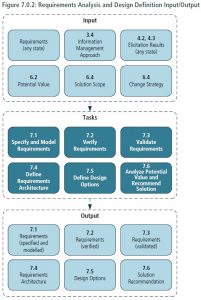The Business Analysis Core Concept Model™ (BACCM™) describes the relationships among the six core concepts. The following table describes the usage and application of each of the core concepts within the context of Requirements Analysis and Design Definition.
Table 7.0.1: The Core Concept Model in Requirements Analysis and Design Definition
| Core Concept | During Business Analysis Planning and Monitoring, business analysts… |
| Change: the act of transformation in response to a need. | transform elicitation results into requirements and designs in order to define the change. |
| Need: a problem or opportunity to be addressed. | analyze the needs in order to recommend a solution that meets the needs. |
| Solution: a specific way of satisfying one or more needs in a context. | define solution options and recommend the one that is most likely to address the need and has the most value. |
| Stakeholder: a group or individual with a relationship to the change, the need, or the solution. | tailor the requirements and designs so that they are understandable and usable by each stakeholder group. |
| Value: the worth, importance, or usefulness of something to a stakeholder within a context. | analyze and quantify the potential value of the solution options. |
| Context: the circumstances that influence, are influenced by, and provide understanding of the change. | model and describe the context in formats that are understandable and usable by all stakeholders. |

The Requirements Analysis and Design Definition knowledge area includes the following tasks:
- Specify and Model Requirements: describes a set of requirements or designs in detail using analytical techniques.
- Verify Requirements: ensures that a set of requirements or designs has been developed in enough detail to be usable by a particular stakeholder, is internally consistent, and is of high quality.
- Validate Requirements: ensures that a set of requirements or designs delivers business value and supports the organization’s goals and objectives.
- Define Requirements Architecture: structures all requirements and designs so that they support the overall business purpose for a change and that they work effectively as a cohesive whole.
- Define Solution Options: identifies, explores and describes different possible ways of meeting the need.
- Analyze Potential Value and Recommend Solution: assesses the business value associated with a potential solution and compares different options, including trade-offs, to identify and recommend the solution option that delivers the greatest overall value.
Chapter 7: Requirements Analysis and Design Definition pg. 136
